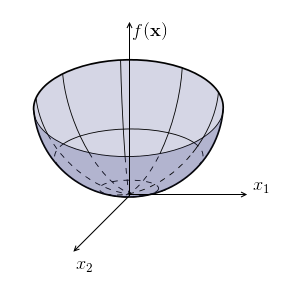Positive-Definite Matrices
Energy-Based Definition
In Linear Algebra, a matrix an $n \times n$ matrix is Positive-definite matrix (PDM) if
- $\mathbf v^T A \mathbf v > 0$ for all $\mathbf v \in \mathbb R^n$
- This is the energy based definition
Why ‘‘energy’’?
- because $\mathbf v^T A \mathbf v$ or $\frac{1}{2} \mathbf v^T A \mathbf v$ is called the ‘‘energy’’ of the system $A$
Positive Semi-Definite Matrices
- A matrix is semi-positive definite if
- $\mathbf v^T A \mathbf v \geqslant 0$ for all $\mathbf v \ne \mathbf 0 \in \mathbb R^n$
- so some eigenvectors can be 0
Motivating Example
- Let $A = \begin{bmatrix}
2 & 6
6 & 18
\end{bmatrix}$ - then for any $\mathbf x = (x_1, x_2)$ we want to check
- $\big[x_1 \ x_2 \big] \begin{bmatrix}
2 & 6
6 & 18
\end{bmatrix} \begin{bmatrix} x_1
x_2
\end{bmatrix} = 2 \, x_1^2 + 12 \, x_1 x_2 + 18 \, x_2^2$ - note that this is not a linear anymore:
- we have an equation $a x_1^2 + 2b \, x_1 x_2 + c \, x_2^2$
- this is a Quadratic Form
- we want to know if this quantity is always positive or not
- are there such $x_1, x_2$ that $a x_1^2 + 2b \, x_1 x_2 + c \, x_2^2 < 0$?
So we have a function $f(\mathbf x) = \mathbf x^T A \, \mathbf x$ and we want to check if it’s always positive for any $\mathbf x$
Another example
- let $A_1 = \begin{bmatrix}
2 & 6
6 & 7
\end{bmatrix}$ - then $f(\mathbf x) = \mathbf x^T A_1 \, \mathbf x = 2 x_1^2 + 12 x_1 x_2 + 7 x_2^2$
- there exists $\mathbf x$ such that $f(\mathbf x) < 0$, e.g. $(1, -1)$
- in this system, there’s a Saddle Point - a max for one direction and min for another

Consider an alternative:
- $A_2 = \begin{bmatrix}
2 & 6
6 & 20
\end{bmatrix}$ - $f(\mathbf x) = \mathbf x^T A_2 \, \mathbf x = 2 x_1^2 + 12 x_1 x_2 + 20 x_2^2$
- here squares always overwhelm $12 x_1 x_2$

We say that $A_1$ is ‘‘indefinite’’, and $A_2$ is ‘‘positive-definite’’
<img src=”” />
Source: [http://brickisland.net/cs177fa12/?p=302]
Finding Minima
Recall from Calculus:
- 1st Derivative is needed for finding extremum, but you don’t know if it’s min or max
- so you have to look for the 2nd derivative to learn if it’s positive or negative
- you want to find $\cfrac{du}{dx} = 0$ and $\cfrac{d^2 \, u}{d \, x^2} > 0$
Consider $A_2$ again:
- $f(\mathbf x) = \mathbf x^T A_1 \, \mathbf x = 2 x_1^2 + 12 x_1 x_2 + 20 x_2^2$
- Let’s complete the square: $2 \, (x_1 + 3 \, x_2)^2 + 2 \, x_2^2$
- now it’s easy to see that this function is indeed always positive: we completed the square and there are no negative terms
What about $A_1$?
- $f(\mathbf x) = \mathbf x^T A_1 \, \mathbf x = 2 x_1^2 + 12 x_1 x_2 + 7 x_2^2$
- let’s try to complete the square: $2 \, (x_1 + 3 \, x_2)^2 - 11 \, x_2^2$
- we have a minus| | |
Matrix vs Function
Let’s have a look again at $A_2$:
- $f(\mathbf x) = \mathbf x^T A_1 \, \mathbf x = 2 x_1^2 + 12 x_1 x_2 + 20 x_2^2 = 2 \, (x_1 + 3 \, x_2)^2 + 2 \, x_2^2$
- the numbers in the completed square form come from Gaussian Elimination| |- Let’s do $A = LU$ transformation: | - $L = \begin{bmatrix}
1 & 0
3 & 1
\end{bmatrix}, U = \begin{bmatrix} \boxed 2 & 6
0 & \boxed 2
\end{bmatrix}$ - multipliers before squares come from pivots of $U$:
- $\boxed{2} \, (x_1 + 3 \, x_2)^2 + \boxed 2 \, x_2^2$
- coefficients inside each square come from $L$
- $2 \, (1 \, x_1 + 3 \, x_2)^2 + 2 \, (0\, x_1 + 1 \, x_2)^2$
- so positive pivots of $U$ are good
Derivative Matrix
So a matrix of second derivatives (Hessian Matrix) is
- $\begin{bmatrix}
\cfrac{\partial x_1^2}{\partial^2 x_1} & \cfrac{\partial x_1 \partial x_2}{\partial x_1 \partial x_2}
\cfrac{\partial x_2 \partial x_1}{\partial x_2 \partial x_1} & \cfrac{\partial x_2^2}{\partial^2 x_2}
\end{bmatrix}$ - we want it to be positive-definite
- then the function $f(\mathbf x) = \mathbf x^T A \, \mathbf x$ is positive-definite
Checking for Positiveness
So, how to check for positive definitiveness?
- using the definition: check that $\mathbf v^T A \mathbf v > 0$ for all $\mathbf v$
- check that all eigenvalues are positive
- or that all pivots of $L$ in $A = LU$ are positive
- or that all Determinants and sub-determinants are positive
Checking using positiveness of eigenvalues:
- if for all $\mathbf v$, $\mathbf v^T A \, \mathbf v > 0$,
- $A \mathbf v = \lambda \mathbf v$, multiply by $\mathbf v^T$ on the left
- $\mathbf v^T A \, \mathbf v = \lambda \mathbf v^T \mathbf v$
-
$\mathbf v^T A \, \mathbf v = \lambda | \mathbf v |^2$ - $| \mathbf v |^2$ is always positive, so it means that if $\lambda > 0$, then so is $\mathbf v^T A \, \mathbf v$ - therefore we can check if all eigenvalues are positive
Properties
Sum
If $A$ and $B$ are both PDM
- then so is $A + B$
- because the energies add when we add matrices:
- $\mathbf v^T A \, \mathbf v + \mathbf v^T B \, \mathbf v$
Inverse
- if $A$ is PDM, the inverse is also PDM
- eigenvalues of the inverse are $\lambda^*_i = \frac{1}{\lambda_i}$
- so eigenvalues are also positive
-
but careful with semi-positive definite matrices: they do not have an inverse
$R^T R$ and $R R^T$ Matrices
They are always semi-positive definite
- see Gram Matrices
Sources
- Linear Algebra MIT 18.06 (OCW)
- Jauregui, Jeff. “Principal component analysis with linear algebra.” (2012). [http://www.math.union.edu/~jaureguj/PCA.pdf]